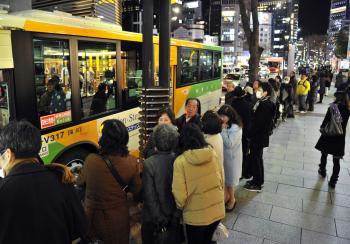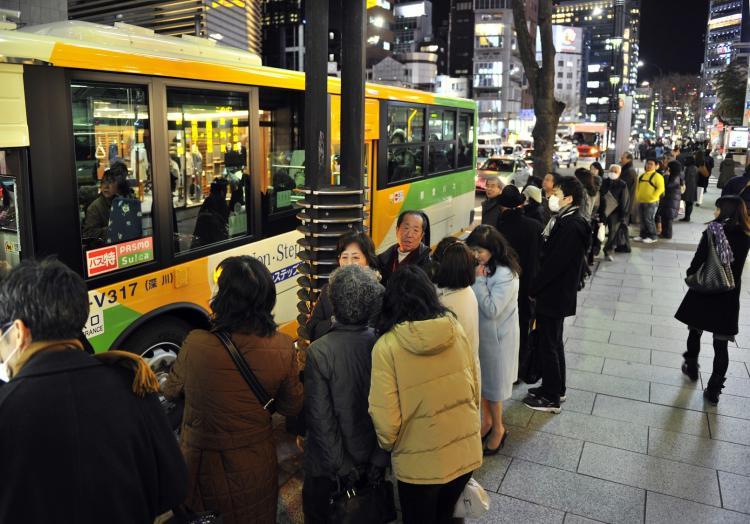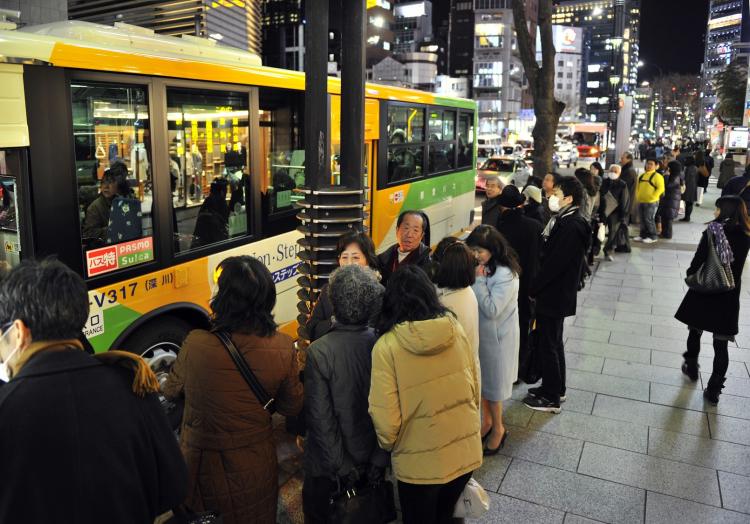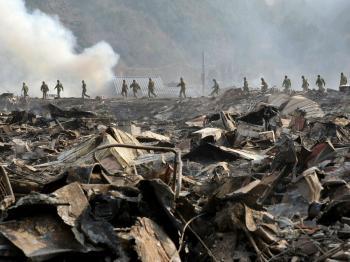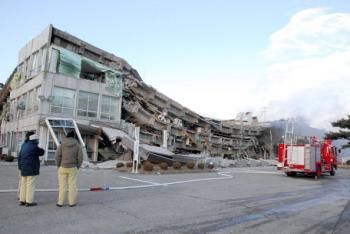TOKYO—With the city’s transportation system paralyzed by the powerful 8.9-magnitude earthquake Friday afternoon local time, Tokyo residents had no choice but to head home by foot, across the sprawling metropolis where long commutes are common.
Tokyo has not fallen into a state of panic, but it is a long journey home for many, and people are worried about aftershocks.
On the streets, people tried to get comfortable for the long walk. Women abandoned their high heels, some people are walking wearing helmets to protect themselves from falling building tiles, while businessmen stop to buy snacks from still-open kiosks along the way. There was a mad rush to any shops that sold bicycles.
Many others, with too far to travel by foot, are sitting outside of train stations, staring at their mobile phone LCD screens, waiting for news about how long they will have to wait before the trains re-open.
In front of Akihabara station, the busy electronics district in central Tokyo, a 29-year-old kiosk manager decided to stay open far later than usual. “People waiting at the station will get hungry and thirsty. So we should not close our shop,” he said, at 10:00 p.m., hours after he’s normally closed. Standing by his wares, weary walkers stop to ask him for directions.
A male programmer, 33, who walked from Takadanobaba to Kanda, about 5.5 miles, to see his family, said, “I never realized how vulnerable we were as soon as we lose transport and communication networks.”
An office worker, 45, who had been on the 38th floor of 50-story building in Shinjuku at the time of the quake said, in an exhausted voice, “I made up my mind when it came: We cannot do anything about it if this is natural disaster plunging up from the earth.”
College students dressed up for graduation stood out among the office workers in their dark suits. The earthquake interrupted their party of 300 people to thank their teachers. “It is cold. I haven’t got clothes to go outside, but I would like to walk back home,” said one student. They had been walking for 3 hours already, trying to make it back to their school, still several hours away.
Two employees from a large printing company were walking, carrying six 22-pound bags of rice. They said they planned to cook dinner for 600 employees. “It is better to stay as a group in a crisis and natural disaster,” one of them said.
According to the metrological department, the earthquake off the shore of Sendai on the east coast of Japan’s main island is the largest they have observed since they began keeping records in 1923. Section chief for monitoring earthquakes and tsunamis, Mr. Yokohama, told reporters at a press conference that it is likely that more aftershocks and tsunamis will occur. “We need to be vigilant for next one month,” he said.
Tokyo has not fallen into a state of panic, but it is a long journey home for many, and people are worried about aftershocks.
On the streets, people tried to get comfortable for the long walk. Women abandoned their high heels, some people are walking wearing helmets to protect themselves from falling building tiles, while businessmen stop to buy snacks from still-open kiosks along the way. There was a mad rush to any shops that sold bicycles.
Many others, with too far to travel by foot, are sitting outside of train stations, staring at their mobile phone LCD screens, waiting for news about how long they will have to wait before the trains re-open.
In front of Akihabara station, the busy electronics district in central Tokyo, a 29-year-old kiosk manager decided to stay open far later than usual. “People waiting at the station will get hungry and thirsty. So we should not close our shop,” he said, at 10:00 p.m., hours after he’s normally closed. Standing by his wares, weary walkers stop to ask him for directions.
A male programmer, 33, who walked from Takadanobaba to Kanda, about 5.5 miles, to see his family, said, “I never realized how vulnerable we were as soon as we lose transport and communication networks.”
An office worker, 45, who had been on the 38th floor of 50-story building in Shinjuku at the time of the quake said, in an exhausted voice, “I made up my mind when it came: We cannot do anything about it if this is natural disaster plunging up from the earth.”
College students dressed up for graduation stood out among the office workers in their dark suits. The earthquake interrupted their party of 300 people to thank their teachers. “It is cold. I haven’t got clothes to go outside, but I would like to walk back home,” said one student. They had been walking for 3 hours already, trying to make it back to their school, still several hours away.
Two employees from a large printing company were walking, carrying six 22-pound bags of rice. They said they planned to cook dinner for 600 employees. “It is better to stay as a group in a crisis and natural disaster,” one of them said.
According to the metrological department, the earthquake off the shore of Sendai on the east coast of Japan’s main island is the largest they have observed since they began keeping records in 1923. Section chief for monitoring earthquakes and tsunamis, Mr. Yokohama, told reporters at a press conference that it is likely that more aftershocks and tsunamis will occur. “We need to be vigilant for next one month,” he said.
